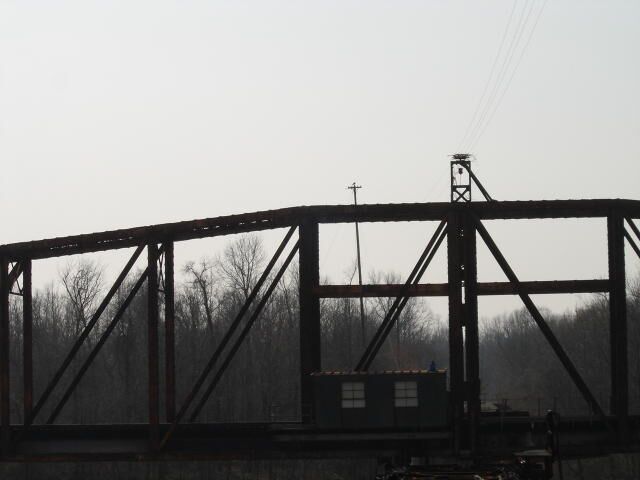|

photo by jrd.
Greetings all and a "Good Day" wish to you. Hope that all is well
in your household. All seems to be well in this household. We seem to be ageing naturally,
but other than that, anything else would be worse......
It had been years since I have been to Smallhous and things have changed quite
drastically since then. I still have a remembrance of the "Turning Bridge", but that
is about all. Other than look, trying my luck at fishing was about the only reason I
had to visit Smallhous.....
Smallhous is an old River Town, located on the Green River a few miles below Ceralvo.
Time has not been good to either of these old river towns and memories are fading fast.
A few houses and a church still exist in Ceralvo. A Smallhous Church still exist, but
it is a mile or so from the old river town. Except for the railroad base, the old
turning bridge, and lots of concrete and rock foundations; there is not much left.
Only snakes, spiders, and other creatures exist where once was a flourishing river
town. A depot foundation still exists as well as a water tank foundation. The old
bridge looks as if it could be made operation, but doubt if that ever happens. An
existing cistern casing seems to beckon anyone to have a drink.......
This old railroad at Smallhous came from the direction of Hartford and headed West
toward the Central City area passing through Centertown, Equality, the Matanzas Area
and other small towns of years past. The original railroad was the LH&S and it
ran from Henderson, KY to St. Louis, Missouri with a side track from the main line
to the coal fields of Western Kentucky. This side track ran through Centertown, Smallhous
and to Central City. The LH&S, or Lousiville, Henderson, and St. Louis, Railroad
Line was purchased by the L&N or the old Louisville and Nashville Railroad in 1909.
This line crossed the Green River at Smallhous. Railroad river crossing was by a "Swing"
or a "Turn" railroad bridge. On the East bank of the river, or the Ohio County side,
was a small depot and a railroad water tank. The depot was the main point of control
for the operation of the swing bridge. The swing bridge, over the Green River, was
normally positioned with the flow of the river so that river traffic would not be hindered.
When a train was "Due", the bridge tender or operator would rotate or swing the bridge
around so that it would line up with the railroad bed. After locking the bridge into
position, the operator would signal the oncoming train that the bridge was ready for
a train crossing. With just a little communications and timing, the train would not
have been caused to even slow down. Once the train crossed, the bridge would again be
swung around and lined up with the flow of the river and river traffic could proceed.
This operation mode could have been reversed, depending on the time of the year, and
the amount of river traffic vrs. the rail traffic. I am guessing that a small gasoline
engine provided the power to swing the bridge, as doubt if electricity was available
in this area, for this time in history. Communications was provided by a Morse Code
System. We all have seen the utility poles along a the railroad right-of-way with the
cross arms and the glass insulators that held the bare copper wires to the poles. At
every Depot, these wires were connected to the telegraph system. Thus, every train
could be in contact with each and every depot. What an unique method of moving freight
and passengers. The times must have been harsh, but they surely would have been
exciting.
An age old question ask; "Which came first, the chicken or the egg?" Guess a good
question concerning Smallhous would be; "Which came first, the railroad or the town?"
Was there a town of Smallhous and the railroad just happened to run through the town
or was the depot and water tank built first and the town sprung up around the railroad?
I do not have the answer to either question, but if guessing, I would say that the
town sprung up after the railroad line crossed the river at this point. Any feedback
here would be appreciated.
As previously mentioned, I know very little about the olden days
of the Railroad, Green River, or Smallhous. It was probably in the mid forties before
I realized what the Green River, or a train with a big and noisy steam engine, was all
about. Thus, if you feel that I have not represented the old town of Smallhous correctly,
I await your input. Thanks for looking and thanks for reading.
See you.......
jrd
"Smallhous Turning Bridge On Green River.".
That small object On top Of the utility pole is a bird-Probably
an Osprey.
Look closely at the tall structure above the bridge-At the top is the
bird's nest. The larger picture above gives a better view.

Click on Bridge to reply.
See you......
jrd
|